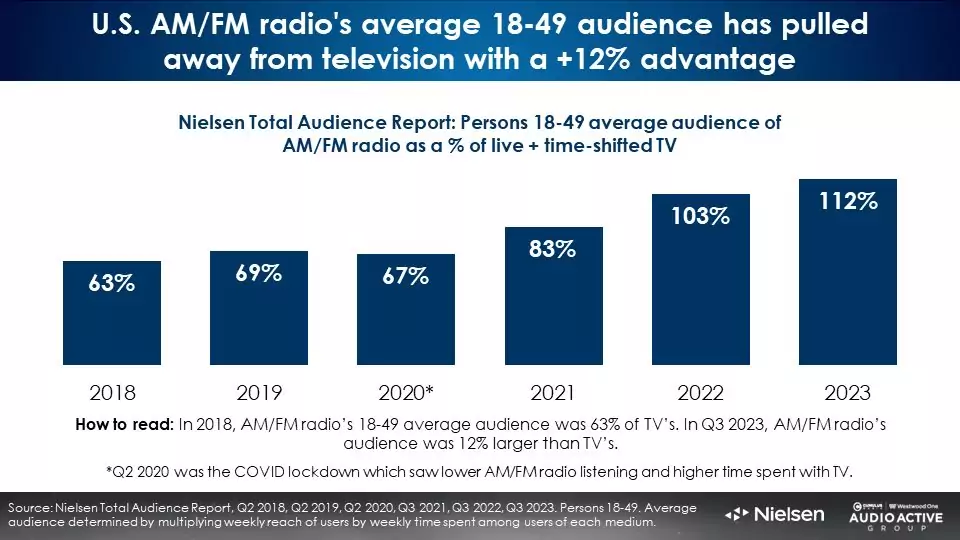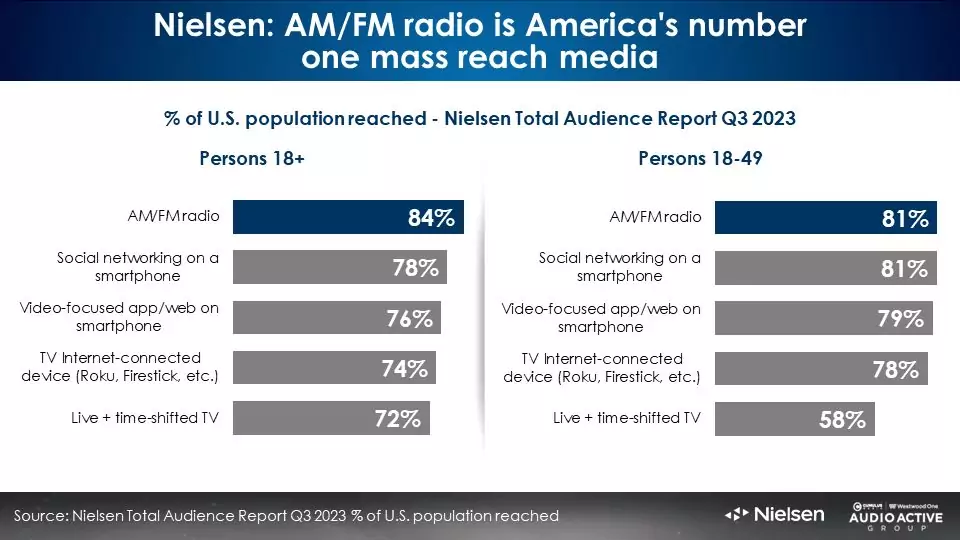
In 2023, Nielsen dropped the blockbuster news that AM/FM radio’s total audience overtook television for the first time in history. Days short of the first anniversary of that study, Nielsen now reveals that three percent advantage has soared as TV gets left behind.
Radio now boasts a 12% larger average audience than TV among 18-49-year-olds. This growth reflects radio’s expanding influence, reaching 40% more individuals in this age group than TV. Daily engagement with both TV and radio is nearly identical, averaging just over an hour, as shown by the Cumulus Media/Westwood One Audio Active Group blog.
TV’s appeal among the 18-49 demographic has significantly declined, with a 29% drop in weekly reach and a 62% decrease in daily viewing time since 2018. Conversely, half of TV’s ad impressions now target individuals aged 65+, highlighting a mismatch with advertisers aiming for a younger audience. In contrast, AM/FM radio presents a more balanced demographic distribution, with 40% aged 18-49.

Nielsen’s Q3 2023 Total Audience Report confirms over-the-air radio remains the most widespread media in America, surpassing social media, online video, TV/internet-connected devices, and traditional TV among adults 18 and older. Particularly among the 18-49 demographic, AM/FM shares the top spot with social media for weekly reach, edging out online video and connected TV devices, with traditional TV ranking fifth.

The World Advertising Research Center emphasizes the importance of reach for media effectiveness, noting growth typically stems from attracting light or infrequent buyers. This underscores the effectiveness of wide-reaching media like AM/FM in driving sales and profits, contrary to the limitations of narrow targeting.
Despite common misconceptions, AM/FM radio listening extends beyond typical “drive times,” with 59% occurring outside these periods. Midday hours attract the most listeners, debunking the myth that drive times dominate radio engagement. Weekend listening also proves more substantial than many advertisers assume, equaling the reach of morning and afternoon drives.







Thank you for supporting with data what I have felt for a long time. Convenience and speed has long been preferred over a leisurely morning reading the paper or watching TV. Grab you coffee, get in the car, turn on the radio and head out on your way.
This is good information.
Interesting story about two challenged industries – as one is dropping faster than the other.
Radio taking the lead “for the first time in history?”
“In 2023, Nielsen dropped the blockbuster news that AM/FM radio’s total audience overtook television for the first time in history. Days short of the first anniversary of that study, Nielsen now reveals that three percent advantage has soared as TV gets left behind.“
The “advantage” may have “soared” as TV has dropped faster – but is this really cause for celebration?
As a strong believer, advocate and activist for a radio revolution in moving back to being a true local medium, it’s important to understand the big picture. The big picture must be changed, and instead hiding by “disguising decline,” we must instead focus on the vision of what radio can be as part of rebuilding effective local media.
Where is this being done? How is this being done? Who is doing it?
We should be celebrating any return to localism and growing radio as part of a multi-platform local connection strategy. To do that, the radio industry, which also includes Nielsen and publications that promote radio would do great service by focusing on what the industry CAN and MUST do to actually engineer growth for a medium, which needs to do so by getting back to localism with a “local experience.”
Unfortunately, this often gets buried by selective data-driven positioning, which overshadows the most important story: What can be done to create a modern, multi-platform local-play, based on identification with familiar local radio brands in individual markets.
Let’s put the lipstick tube away and instead, start building something new, surprisingly different and as winner.
It CAN be done!
To me, THAT is true positivity!
“Radio is Fundamentally a LOCAL Business”
I absolutely agree with the data. Although I am not in the 18-49 years old demographic I have three, hard working adult daughters who are.
One of them listens to radio during her working hours.
One only listens alongside me during drive times.
The third infrequently listens to radio if at all.
I inherited my mom’s love for radio listening and passed it down to my own daughters. I even started my newborn grandchild listening to religious, Detroit Tigers/Lions sports and some music via radio!
I listen to radio most days before, during and after work. It has replaced t.v. watching and online listening substantially. Although, and this is huge, if radio producers stay on the trajectory of racial and political divisive programming I will simply turn off the radio. I, and my daughters, want to patronize sponsors who demand factual, accurate, entertaining and informative content across all genres.